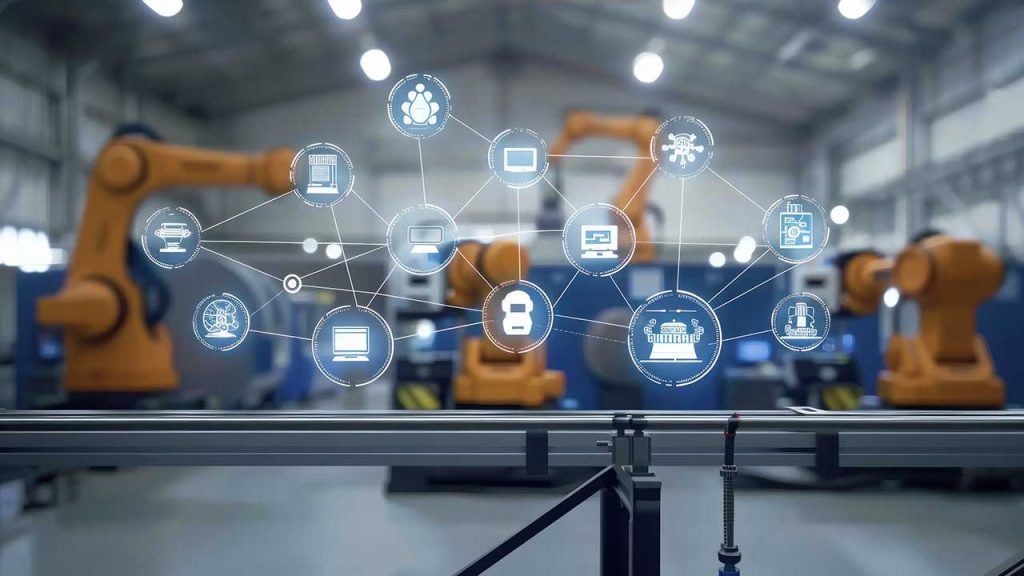The Next Manufacturing Advantage: From Products to Intelligent, Connected Services
Machines and software are everywhere. The next competitive edge no longer comes from owning more of them — it comes from connecting, learning, and evolving faster than the competition. For manufacturers, the challenge is no longer adopting technology but turning it into a measurable, repeatable advantage.
From Efficiency to Intelligence
Technology is rewriting the rules of manufacturing faster than organizational structures, supply chains, and budgets can adapt. Every wave of innovation changes what customers expect, how rivals compete, and what regulators demand. Yet it also opens new doors for those who can adapt first.
The old levers of cost and quality are still essential, but they no longer guarantee leadership. Two companies can produce equally good machines at similar prices, but the one that guarantees uptime, predicts failures before they happen, and continuously improves performance will win the next contract — and the one after that.
Today’s advantage comes from understanding where technology truly pays back, which signals to trust, and how to turn one successful project into a repeatable system that scales across products, plants, and markets.
Redefining the Competitive Edge
The manufacturing business model has undergone a fundamental shift. Customers no longer want to simply buy equipment — they want outcomes. They expect predictable uptime, stable costs, and measurable value long after delivery.
Meanwhile, manufacturers face pressure on all sides: tougher SLAs, environmental targets, supply disruptions, and global competition that punishes inefficiency. Success now depends on new differentiators:
- Reliability is part of the offer. Performance in the field is the new benchmark. Manufacturers are expected to guarantee uptime and deliver rapid resolution when issues occur.
- Lifecycle cost and risk control. Buyers look beyond purchase price, valuing partners who can minimize cost-to-serve and warranty leakage over time.
- Operational resilience. Disruptions are no longer rare. Companies that can quickly adapt their supply and service networks maintain customer trust when others falter.
- Verified sustainability and compliance. Environmental and security claims must now be proven, not assumed. Traceability, data integrity, and audit readiness are part of the brand.
- Adaptation speed. Fast, incremental improvement — using real data from the field — separates the leaders from those who rely on annual planning cycles.
At the core of these shifts is a new definition of value: standing behind performance, managing risk throughout the lifecycle, and learning faster than competitors.
Servitization: From Products to Outcomes
One of the most profound transformations reshaping manufacturing is servitization—the shift from selling equipment to delivering ongoing outcomes.
This approach treats each product not as the end of a sale but as the start of a relationship. Contracts increasingly bundle uptime, maintenance, and performance guarantees. The reward is clear: while new equipment sales typically carry margins of around 10%, service contracts can deliver margins of 25% or more. McKinsey reports that OEMs with strong service offerings achieve a total shareholder return twice that of their peers.
Servitization offers tangible strategic advantages:
- Recurring, predictable revenue that smooths cash flow and reduces dependency on volatile sales cycles.
- Stronger customer retention, as long-term service contracts make relationships deeper and harder to replace.
- Higher operational efficiency, driven by proactive maintenance and real-time monitoring.
- Sharper differentiation, as demonstrated by proven performance under contract, builds trust and provides margin protection.
But this shift also changes what manufacturers bring to market. The product is no longer a standalone machine; it is a connected platform that continually evolves.
Connected Products: The Engine of Servitization
Connected products lie at the heart of this evolution. Machines that stream operational data to the cloud enable manufacturers to monitor performance in real-time, predict maintenance needs, deliver remote updates, and continuously improve.
In this model, value is not locked in the hardware but in the data loop between the customer, product, and service team. Each connected device becomes both a feedback channel and a revenue stream.
Most manufacturers take a phased approach. They start with one product line where the service-based model has clear potential, prove it in partnership with customers, and scale from there. As connected systems expand across the portfolio, they establish a foundation for recurring revenue and more in-depth, data-driven customer relationships.
The Role of AI in Manufacturing Evolution
Artificial intelligence often sits at the top of every innovation agenda — and for good reason. In manufacturing, AI isn’t about futuristic automation; it’s about improving daily reliability, quality, and speed.
AI is transforming maintenance, quality control, and production planning. Predictive maintenance can cut unplanned downtime by 10–20% and reduce maintenance costs by up to 15%. AI-driven inspection can lower defect rates by up to 30%.
Leading companies are already realizing measurable results. ASML used AI to analyze photolithography machine data, achieving a tenfold performance boost and a 40% reduction in time-to-market within six months. General Electric applied AI to turbine data, cutting downtime by 30% and maintenance costs by 15%.
When done right, AI becomes a profit lever. It predicts failures, identifies bottlenecks, automates repetitive tasks, and improves resource efficiency across plants. But success depends on the ecosystem around it: unified data, clear governance, and disciplined scaling.
Organizations that treat AI as both an infrastructure and a capability — investing in master data management, setting use-case frameworks, and integrating insights into operations — are the ones turning pilots into everyday practice.
From Smart Factories to Smarter Businesses
The smart factory concept extends this logic further. It’s not about isolated automation but connected collaboration between humans and machines.
Sensors capture live data from production lines and feed it into ERP, MES, and SCADA systems. AI tools analyze the data in real time, generating insights and alerts for workers to act upon. This closed loop allows teams to spot issues early, optimize workflows, and continuously refine operations.
When implemented strategically, smart factories don’t just lower costs — they make the entire organization faster, more flexible, and more resilient.
Yet success depends on organizational readiness. Many companies fall into “pilot purgatory,” where prototypes never scale because they fail to align with existing business processes. The solution often lies in partnerships with technology experts who understand both manufacturing operations and enterprise-scale deployment.
The next phase of industrial leadership will belong to companies that combine these capabilities — connected products, AI-powered operations, and smart factories — into a cohesive system. But as manufacturers become more data-driven, one more ingredient becomes essential: trust. And that’s where the next transformation begins.
About the author
 This article was written by Natalya Zheltukhina, Partner Network Manager at Sigma Software Group, DACH Region. Natalya is responsible for growing Sigma Software Group’s business on the DACH market, with a dedicated focus on the Automotive, Logistics, and Industrial Manufacturing Sectors.
This article was written by Natalya Zheltukhina, Partner Network Manager at Sigma Software Group, DACH Region. Natalya is responsible for growing Sigma Software Group’s business on the DACH market, with a dedicated focus on the Automotive, Logistics, and Industrial Manufacturing Sectors.



